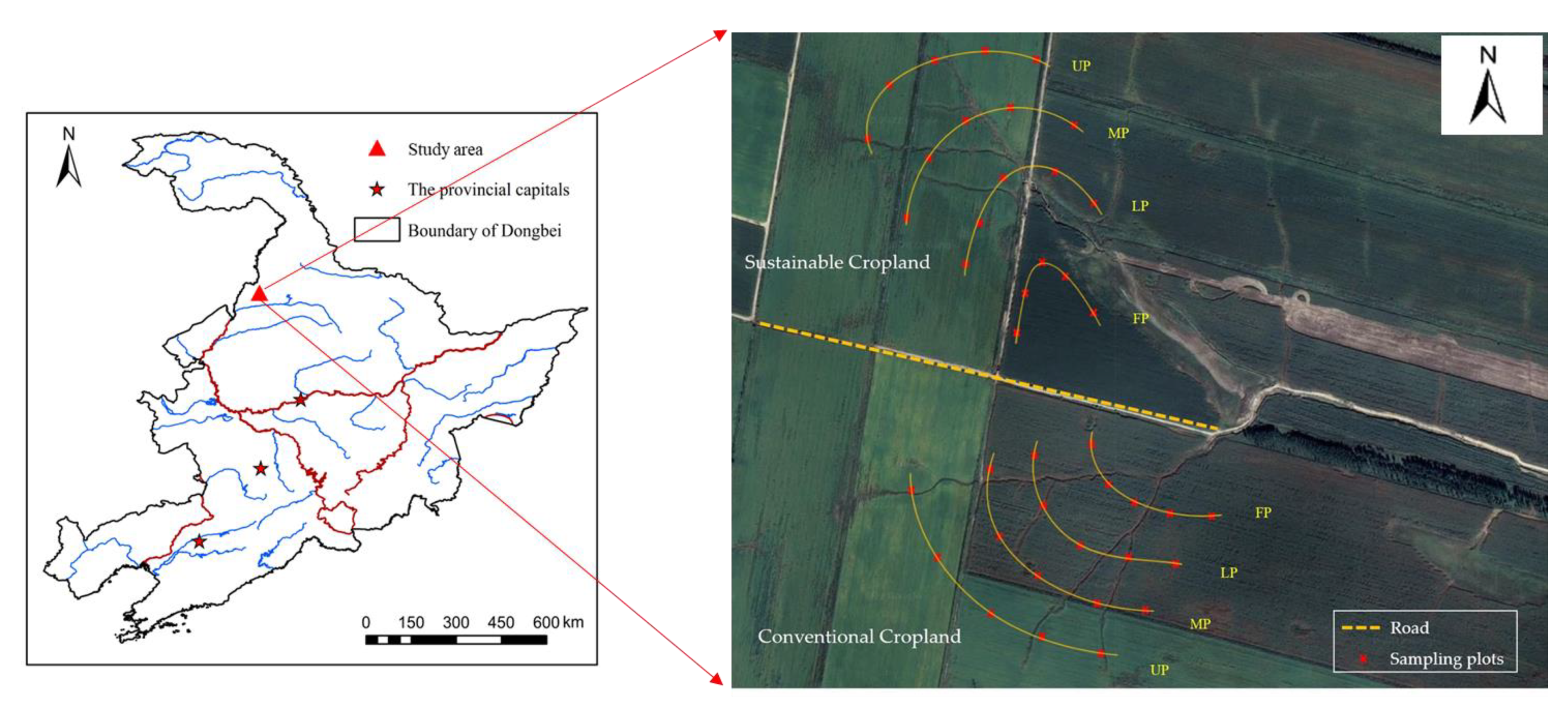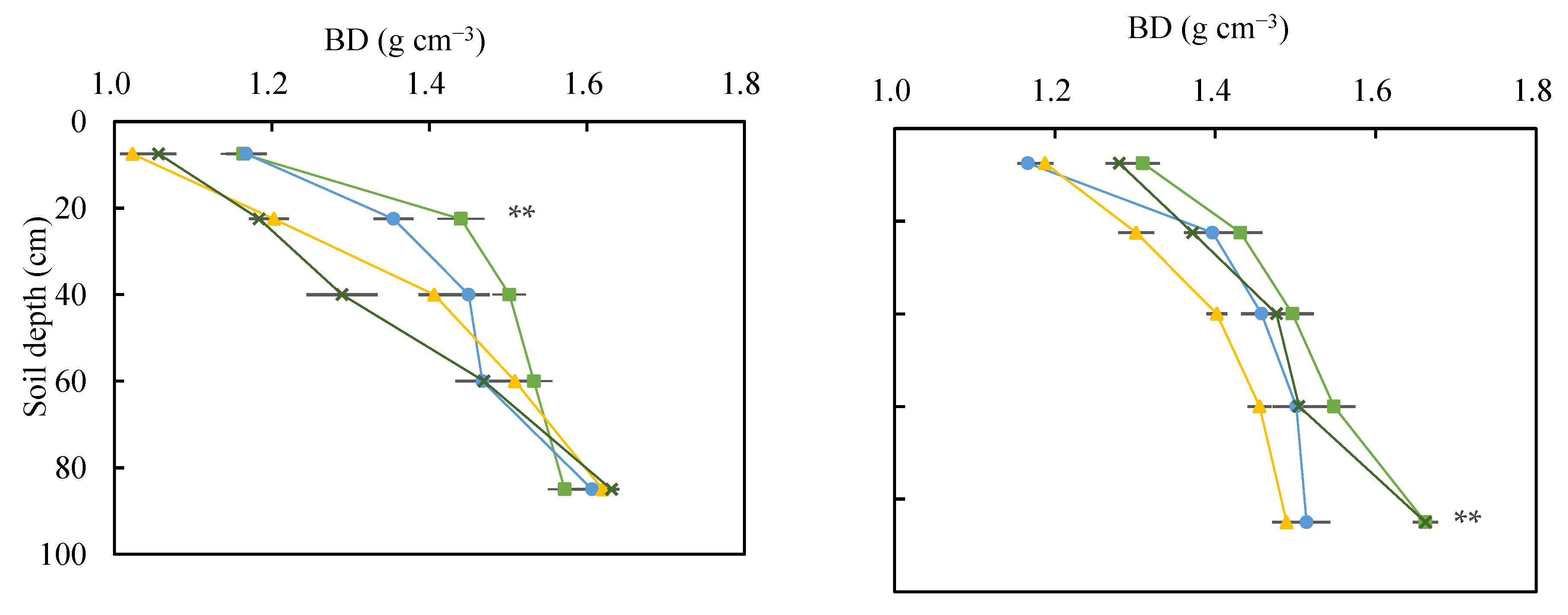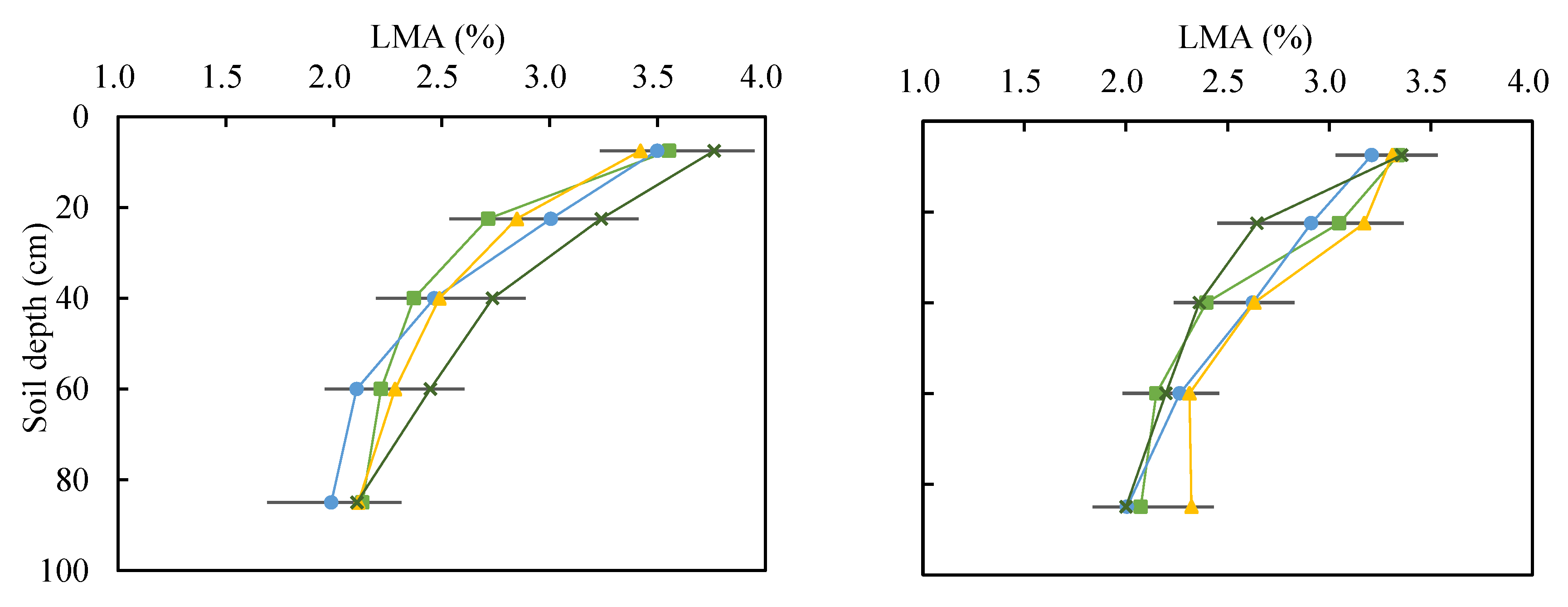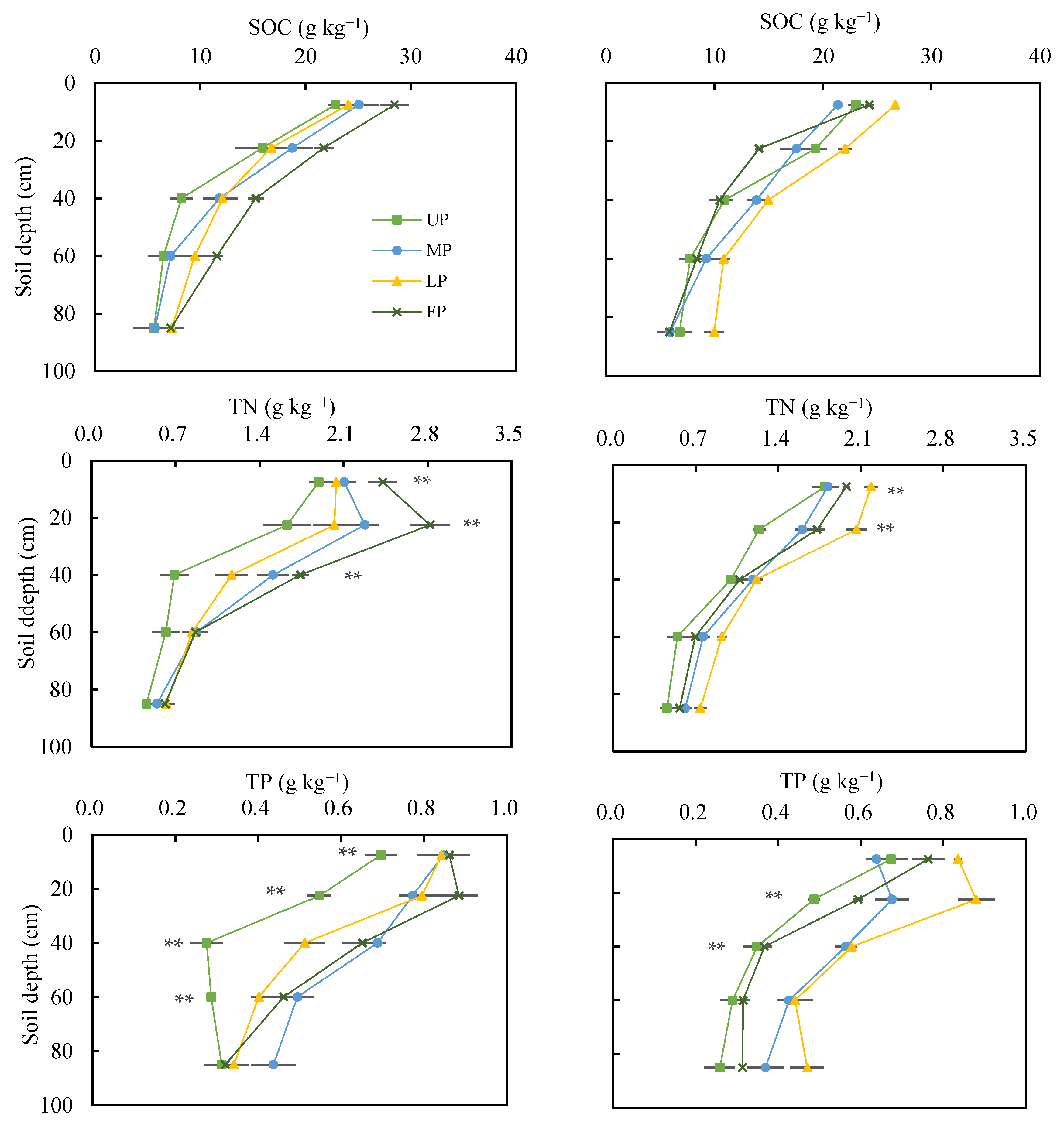Spatial Variation in Soil Physico-Chemical Properties along Slope Position in a Small Agricultural Watershed Scale
Abstract
1. Introduction
2. Materials and Methods
2.1. Study Area
2.2. Field Investigation and Soil Sampling
2.3. Measurement of Soil Properties
2.4. Statistical Analysis
3. Results
3.1. Effect of Slope Position and Cropland Management on Bulk Density and Saturated Hydraulic Conductivity
3.2. Effect of Slope Position and Cropland Management on Water-Stable Aggregates
3.3. Effect of Slope Position and Cropland Management on Organic Carbon, Nitrogen, and Phosphorus
4. Discussion
4.1. Effect of Slope Position and Cropland Management on Bulk Density and Saturated Hydraulic Conductivity
4.2. Effect of Slope Position and Cropland Management on Water-Stable Aggregates
4.3. Effect of Slope Position and Cropland Management on Organic Carbon, Nitrogen, and Phosphorus
5. Conclusions
Author Contributions
Funding
Data Availability Statement
Acknowledgments
Conflicts of Interest
References
- Zhao, P.; Li, S.; Wang, E.; Chen, X.; Deng, J.; Zhao, Y. Tillage erosion and its effect on spatial variations of soil organic carbon in the black soil region of China. Soil Tillage Res. 2018, 178, 72–81. [Google Scholar] [CrossRef]
- Wang, H.; Yang, S.; Wang, Y.; Gu, Z.; Xiong, S.; Huang, X.; Sun, M.; Zhang, S.; Guo, L.; Cui, J.; et al. Rates and causes of black soil erosion in Northeast China. Catena 2022, 214, 106250. [Google Scholar] [CrossRef]
- Huang, D.; Su, L.; Zhou, L.; Fan, H. Gully is the dominant sediment source of snowmelt erosion in the black soil region—A case study. Soil Tillage Res. 2022, 215, 105232. [Google Scholar] [CrossRef]
- Behnke, G.D.; Zuber, S.M.; Pittelkow, C.M.; Nafziger, E.D.; Villamil, M.B. Long-term crop rotation and tillage effects on soil greenhouse gas emissions and crop production in Illinois, USA. Agric. Ecosyst. Environ. 2018, 261, 62–70. [Google Scholar] [CrossRef]
- Ran, L.; Shi, H.; Yang, X. Magnitude and drivers of CO2 and CH4 emissions from an arid/semiarid river catchment on the Chinese Loess Plateau. J. Hydrol. 2021, 598, 126260. [Google Scholar] [CrossRef]
- Maleki, S.; Karimi, A.; Zeraatpisheh, M.; Poozeshi, R.; Feizi, H. Long-term cultivation effects on soil properties variations in different landforms in an arid region of eastern Iran. Catena 2021, 206, 105465. [Google Scholar] [CrossRef]
- Cavalcanti, R.Q.; Rolim, M.M.; De Lima, R.P.; Tavares, U.E.; Pedrosa, E.M.; Gomes, I.F. Soil physical and mechanical attributes in response to successive harvests under sugarcane cultivation in Northeastern Brazil. Soil Tillage Res. 2019, 189, 140–147. [Google Scholar] [CrossRef]
- Lu, S.; Liu, B.; Hu, Y.; Fu, S.; Cao, Q.; Shi, Y.; Huang, T. Soil erosion topographic factor (LS): Accuracy calculated from different data sources. Catena 2020, 187, 104334. [Google Scholar] [CrossRef]
- Jin, F.; Yang, W.; Fu, J.; Li, Z. Effects of vegetation and climate on the changes of soil erosion in the Loess Plateau of China. Sci. Total Environ. 2021, 773, 145514. [Google Scholar] [CrossRef]
- Ma, Y.; Li, Z.; Deng, C.; Yang, J.; Tang, C.; Duan, J.; Zhang, Z.; Liu, Y. Effects of tillage-induced soil surface roughness on the generation of surface–subsurface flow and soil loss in the red soil sloping farmland of southern China. Catena 2022, 213, 106230. [Google Scholar] [CrossRef]
- Liu, Z.; Cao, S.; Sun, Z.; Wang, H.; Qu, S.; Lei, N.; He, J.; Dong, Q. Tillage effects on soil properties and crop yield after land reclamation. Sci. Rep. 2021, 11, 4611. [Google Scholar] [CrossRef] [PubMed]
- Tepes, A.; Galarraga, I.; Markandya, A.; Sánchez, M.J.S. Costs and benefits of soil protection and sustainable land management practices in selected European countries: Towards multidisciplinary insights. Sci. Total Environ. 2021, 756, 143925. [Google Scholar] [CrossRef] [PubMed]
- Lessmann, M.; Ros, G.H.; Young, M.D.; de Vries, W. Global variation in soil carbon sequestration potential through improved cropland management. Glob. Chang. Biol. 2022, 28, 1162–1177. [Google Scholar] [CrossRef] [PubMed]
- Tagar, A.A.; Adamowski, J.; Memon, M.S.; Do, M.C.; Mashori, A.S.; Soomro, A.S.; Bhayo, W.A. Soil fragmentation and aggregate stability as affected by conventional tillage implements and relations with fractal dimensions. Soil Tillage Res. 2020, 197, 104494. [Google Scholar] [CrossRef]
- Xiao, L.; Kuhn, N.; Zhao, R.; Cao, L. Net effects of conservation agriculture principles on sustainable land use: A synthesis. Glob. Chang. Biol. 2021, 27, 6321–6330. [Google Scholar] [CrossRef]
- Panettieri, M.; de Sosa, L.; Domínguez, M.; Madejón, E. Long-term impacts of conservation tillage on Mediterranean agricultural soils: Shifts in microbial communities despite limited effects on chemical properties. Agric. Ecosyst. Environ. 2020, 304, 107144. [Google Scholar] [CrossRef]
- Anache, J.A.; Wendland, E.C.; Oliveira, P.T.; Flanagan, D.C.; Nearing, M.A. Runoff and soil erosion plot-scale studies under natural rainfall: A meta-analysis of the Brazilian experience. Catena 2017, 152, 29–39. [Google Scholar] [CrossRef]
- Yang, J.; El-Kassaby, Y.A.; Guan, W. The effect of slope aspect on vegetation attributes in a mountainous dry valley, Southwest China. Sci. Rep. 2020, 10, 16465. [Google Scholar] [CrossRef]
- Niu, Y.H.; Wang, L.; Wan, X.G.; Peng, Q.Z.; Huang, Q.; Shi, Z.H. A systematic review of soil erosion in citrus orchards worldwide. Catena 2021, 206, 105558. [Google Scholar] [CrossRef]
- Dai, J.; Zhang, J.; Zhang, Z.; Jia, L.; Xu, H.; Wang, Y. Effects of water discharge rate and slope gradient on runoff and sediment yield related to tillage erosion. Arch. Agron. Soil Sci. 2021, 67, 849–861. [Google Scholar] [CrossRef]
- Lin, J.; Huang, Y.; Zhao, G.; Jiang, F.; Wang, M.K.; Ge, H. Flow-driven soil erosion processes and the size selectivity of eroded sediment on steep slopes using colluvial deposits in a permanent gully. Catena 2017, 157, 47–57. [Google Scholar] [CrossRef]
- Tuo, D.; Xu, M.; Gao, G. Relative contributions of wind and water erosion to total soil loss and its effect on soil properties in sloping croplands of the Chinese Loess Plateau. Sci. Total Environ. 2018, 633, 1032–1040. [Google Scholar] [CrossRef] [PubMed]
- Bojko, O.; Kabala, C. Transformation of physicochemical soil properties along a mountain slope due to land management and climate changes—A case study from the Karkonosze Mountains, SW Poland. Catena 2016, 140, 43–54. [Google Scholar] [CrossRef]
- Xu, M.; Cardenas, L.; Horrocks, C.; Lopez-Aizpun, M.; Zhang, J.; Zhang, F.; Dungait, J. The effect of tillage management on microbial functions in a maize crop at different slope positions. Geoderma 2021, 401, 115171. [Google Scholar] [CrossRef]
- Li, H.; Liao, X.; Zhu, H.; Wei, X.; Shao, M. Soil physical and hydraulic properties under different land uses in the black soil region of Northeast China. Can. J. Soil Sci. 2019, 99, 406–419. [Google Scholar] [CrossRef]
- USDA. Soil Taxonomy: A Basic System of Soil Classification for Making and Interpreting Soil Survey; Government Printing Office: Washington, DC, USA, 1975.
- Zhang, Y.; Wu, Y.; Liu, B.; Zheng, Q.; Yin, J. Characteristics and factors controlling the development of ephemeral gullies in cultivated catchments of black soil region, Northeast China. Soil Tillage Res. 2007, 96, 28–41. [Google Scholar] [CrossRef]
- Li, Q.; Fang, H.; Sun, L.; Cai, Q. Using the 137Cs technique to study the effect of soil redistribution on soil organic carbon and total nitrogen stocks in an agricultural catchment of Northeast China. Land Degrad. Dev. 2012, 25, 350–359. [Google Scholar] [CrossRef]
- Dong, Y.; Wu, Y.; Qin, W.; Guo, Q.; Yin, Z.; Duan, X. The gully erosion rates in the black soil region of northeastern China: Induced by different processes and indicated by different indexes. Catena 2019, 182, 104146. [Google Scholar] [CrossRef]
- Nelson, D.W.; Sommers, L.E. Methods of soil analysis: Part 3 Chemical methods. In Total Carbon, Organic Carbon, and Organic Matter; Sparks, D.L., Ed.; Soil Science Society of America: Madison, WI, USA, 1996; pp. 961–1010. [Google Scholar]
- Kjeldahl, C. A new method for the determination of nitrogen in organic matter. Anal. Chem. 1883, 22, 366. [Google Scholar] [CrossRef]
- Olsen, S.R.; Sommers, L.E. Methods of soil analysis Part 2, Chemical and microbial properties. In Phosphorous; Miller, R.H., Keeney, D.R., Eds.; Agronomy Society of America: Madison, WI, USA, 1982; pp. 403–430. [Google Scholar]
- Six, J.; Elliott, E.T.; Paustian, K.; Doran, J.W. Aggregation and soil organic matter accumulation in cultivated and native grassland soils. Soil Sci. Soc. Am. J. 1998, 62, 1367–1377. [Google Scholar] [CrossRef]
- Klute, A.; Dirksen, C. Methods of soil analysis, part 1: Physical and mineralogical methods. In Hydraulic Conductivity and Diffusivity: Laboratory Methods, 2nd ed.; Klute, A., Ed.; Agronomy Society of America: Madison, WI, USA, 1986; pp. 687–734. [Google Scholar]
- Liu, L.; Lu, Y.; Fu, Y.; Horton, R.; Ren, T. Estimating soil water suction from texture, bulk density and electrical resistivity. Geoderma 2022, 409, 115630. [Google Scholar] [CrossRef]
- Shi, P.; Schulin, R. Erosion-induced losses of carbon, nitrogen, phosphorus and heavy metals from agricultural soils of contrasting organic matter management. Sci. Total Environ. 2018, 618, 210–218. [Google Scholar] [CrossRef]
- Heckrath, G.; Halekoh, U.; Djurhuus, J.; Govers, G. The effect of tillage direction on soil redistribution by mouldboard ploughing on complex slopes. Soil Tillage Res. 2006, 88, 225–241. [Google Scholar] [CrossRef]
- Li, Y.; Tian, G.; Lindstrom, M.; Bork, H. Variation of surface soil quality parameters by intensive donkey-drawn tillage on steep slope. Soil Sci. Soc. Am. J. 2004, 68, 907–913. [Google Scholar] [CrossRef]
- Oztas, T.; Koc, A.; Comakli, B. Changes in vegetation and soil properties along a slope on overgrazed and eroded rangelands. J. Arid Environ. 2003, 55, 93–100. [Google Scholar] [CrossRef]
- Zou, C.B.; Turton, D.J.; Will, R.E.; Engle, D.M.; Fuhlendorf, S.D. Alteration of hydrological processes and streamflow with juniper (Juniperus virginiana) encroachment in a mesic grassland catchment. Hydrol. Process. 2014, 28, 6173–6182. [Google Scholar] [CrossRef]
- Morse, J.L.; Megonigal, J.P.; Walbridge, M.R. Sediment nutrient accumulation and nutrient availability in two tidal freshwater marshes along the Mattaponi River, Virginia, USA. Biogeochemistry 2004, 69, 175–206. [Google Scholar] [CrossRef]
- Kirchhof, G.; Salako, F.K. Residual tillage and bush-fallow effects on soil properties and maize intercropped with legumes on a tropical Alfisol. Soil Use Manag. 2000, 16, 183–188. [Google Scholar] [CrossRef]
- Celik, I.; Gunal, H.; Budak, M.; Akpinar, C. Effects of long-term organic and mineral fertilizers on bulk density and penetration resistance in semi-arid Mediterranean soil conditions. Geoderma 2010, 160, 236–243. [Google Scholar] [CrossRef]
- Li, H.; Zhu, H.; Liang, C.; Wei, X.; Yao, Y. Soil erosion significantly decreases aggregate-associated OC and N in agricultural soils of Northeast China. Agric. Ecosyst. Environ. 2022, 323, 107677. [Google Scholar] [CrossRef]
- Li, H.; Yao, Y.; Zhang, X.; Zhu, H.; Wei, X. Changes in soil physical and hydraulic properties following the conversion of forest to cropland in the black soil region of Northeast China. Catena 2021, 198, 104986. [Google Scholar] [CrossRef]
- Walker, C.; Lin, H.S. Soil property changes after four decades of wastewater irrigation: A landscape perspective. Catena 2008, 73, 63–74. [Google Scholar] [CrossRef]
- Badía, D.; Martí, C.; Aznar, J.M.; León, J. Influence of slope and parent rock on soil genesis and classification in semiarid mountainous environments. Geoderma 2013, 193, 13–21. [Google Scholar] [CrossRef]
- Rodenburg, J.; Stein, A.; van Noordwijk, M.; Ketterings, Q.M. Spatial variability of soil pH and phosphorus in relation to soil run-off following slash-and-burn land clearing in Sumatra, Indonesia. Soil Tillage Res. 2003, 71, 1–14. [Google Scholar] [CrossRef]
- Hao, Y.; Lal, R.; Owens, L.B.; Izaurralde, R.C.; Post, W.M.; Hothem, D.L. Effect of cropland management and slope position on soil organic carbon pool at the North Appalachian Experimental Watersheds. Soil Tillage Res. 2002, 68, 133–142. [Google Scholar] [CrossRef]
- Hoyos, N.; Comerford, N.B. Land use and landscape effects on aggregate stability and total carbon of Andisols from the Colombian Andes. Geoderma 2005, 129, 268–278. [Google Scholar] [CrossRef]
- Ayoubi, S.; Karchegani, P.M.; Mosaddeghi, M.R.; Honarjoo, N. Soil aggregation and organic carbon as affected by topography and land use change in western Iran. Soil Tillage Res. 2012, 121, 18–26. [Google Scholar] [CrossRef]
- Pierson, F.B.; Mulla, D.J. Aggregate stability in the Palouse region of Washington: Effect of landscape position. Soil Sci. Soc. Am. J. 1990, 54, 1407–1412. [Google Scholar] [CrossRef]
- Ricci, G.F.; Jeong, J.; De Girolamo, A.M.; Gentile, F. Effectiveness and feasibility of different management practices to reduce soil erosion in an agricultural watershed. Land Use Policy 2020, 90, 104306. [Google Scholar] [CrossRef]






| LMA | SMA | MI | SC | |||||
|---|---|---|---|---|---|---|---|---|
| F | P | F | P | F | P | F | P | |
| SP | 1.58 | 0.25 | 16.56 | <0.01 | 8.59 | <0.01 | 1.16 | 0.36 |
| CMS | 2.48 | 0.14 | 2.26 | 0.16 | 2.66 | 0.129 | 8.13 | 0.02 |
| D | 161.66 | <0.01 | 79.92 | 0.07 | 31.16 | 0.137 | 31.63 | 0.42 |
| SP × CMS | 6.81 | <0.01 | 3.07 | <0.01 | 2.23 | <0.01 | 1.02 | <0.01 |
| SP × D | 0.71 | 0.72 | 0.69 | 0.74 | 0.81 | 0.638 | 0.58 | 0.82 |
| CMS × D | 1.60 | 0.24 | 3.54 | 0.04 | 2.97 | 0.06 | 5.52 | <0.01 |
| Management | Depth (cm) | Organic Carbon Stock (kg m−2) | Total Nitrogen Stock (kg m−2) | Total Phosphorus Stock (kg m−2) | |||||||||
|---|---|---|---|---|---|---|---|---|---|---|---|---|---|
| Upper | Middle | Lower | Footslope | Upper | Middle | Lower | Footslope | Upper | Middle | Lower | Footslope | ||
| Sustainable cropland | 0–15 | 3.94 ± 0.06 | 4.19 ± 0.16 | 4.05 ± 0.16 | 4.34 ± 0.14 | 0.33 ± 0.02 | 0.35 ± 0.06 | 0.34 ± 0.03 | 0.37 ± 0.04 | 0.09 ± 0.02 | 0.14 ± 0.03 | 0.14 ± 0.03 | 0.13 ± 0.02 |
| 15–30 | 3.54 ± 0.19 | 3.63 ± 0.13 | 3.19 ± 0.12 | 4.47 ± 0.13 | 0.32 ± 0.07 b | 0.43 ± 0.04 ab | 0.40 ± 0.09 ab | 0.55 ± 0.01 a | 0.15 ± 0.05 | 0.12 ± 0.02 | 0.15 ± 0.05 | 0.15 ± 0.03 | |
| 30–50 | 2.53 ± 0.18 | 3.58 ± 0.25 | 3.43 ± 0.11 | 4.38 ± 0.15 | 0.20 ± 0.06 b | 0.52 ± 0.09 a | 0.35 ± 0.08 ab | 0.57 ± 0.06 a | 0.09 ± 0.03 | 0.22 ± 0.05 | 0.15 ± 0.02 | 0.19 ± 0.02 | |
| 50–70 | 2.05 ± 0.15 | 2.80 ± 0.16 | 3.23 ± 0.15 | 3.16 ± 0.16 | 0.20 ± 0.05 | 0.31 ± 0.05 | 0.28 ± 0.03 | 0.26 ± 0.04 | 0.09 ± 0.03 | 0.18 ± 0.02 | 0.13 ± 0.04 | 0.13 ± 0.03 | |
| 70–100 | 2.66 ± 0.22 | 3.07 ± 0.14 | 4.37 ± 0.17 | 4.05 ± 0.14 | 0.24 ± 0.08 | 0.28 ± 0.04 | 0.36 ± 0.06 | 0.34 ± 0.09 | 0.18 ± 0.02 | 0.25 ± 0.06 | 0.19 ± 0.06 | 0.16 ± 0.02 | |
| 0–100 | 14.73 ± 0.10 b | 17.27 ± 0.17 ab | 18.28 ± 0.15 ab | 20.39 ± 0.18 a | 1.30 ± 0.06 b | 1.89 ± 0.08 a | 1.72 ± 0.08 a | 2.10 ± 0.05 a | 0.60 ± 0.06 | 0.91 ± 0.07 | 0.76 ± 0.07 | 0.77 ± 0.05 | |
| Conventional cropland | 0–15 | 4.42 ± 0.04 | 3.91 ± 0.15 | 4.72 ± 0.14 | 3.83 ± 0.15 | 0.34 ± 0.01 | 0.34 ± 0.08 | 0.40 ± 0.05 | 0.32 ± 0.05 | 0.13 ± 0.01 | 0.13 ± 0.04 | 0.14 ± 0.02 | 0.12 ± 0.03 |
| 15–30 | 3.68 ± 0.14 ab | 3.86 ± 0.14 ab | 4.79 ± 0.16 a | 2.09 ± 0.10 b | 0.21 ± 0.05 b | 0.35 ± 0.04 ab | 0.41 ± 0.08 a | 0.26 ± 0.04 ab | 0.09 ± 0.03 c | 0.14 ± 0.01 ab | 0.17 ± 0.03 a | 0.09 ± 0.02 bc | |
| 30–50 | 2.81 ± 0.15 | 4.02 ± 0.08 | 2.66 ± 0.13 | 1.90 ± 0.12 | 0.31 ± 0.09 | 0.37 ± 0.04 | 0.21 ± 0.01 | 0.20 ± 0.08 | 0.10 ± 0.05 | 0.12 ± 0.04 | 0.11 ± 0.05 | 0.08 ± 0.03 | |
| 50–70 | 2.18 ± 0.11 | 3.18 ± 0.07 | 1.84 ± 0.13 | 1.82 ± 0.13 | 0.15 ± 0.04 | 0.25 ± 0.03 | 0.22 ± 0.05 | 0.17 ± 0.04 | 0.09 ± 0.06 | 0.10 ± 0.02 | 0.08 ± 0.02 | 0.07 ± 0.02 | |
| 70–100 | 3.01 ± 0.04 | 2.68 ± 0.25 | 4.41 ± 0.14 | 2.47 ± 0.17 | 0.21 ± 0.01 | 0.28 ± 0.09 | 0.23 ± 0.09 | 0.24 ± 0.03 | 0.13 ± 0.03 | 0.13 ± 0.05 | 0.14 ± 0.04 | 0.14 ± 0.02 | |
| 0–100 | 16.10 ± 0.26 ab | 17.66 ± 0.19 ab | 18.43 ± 0.15 a | 12.10 ± 0.14 b | 1.23 ± 0.07 | 1.59 ± 0.07 | 1.47 ± 0.06 | 1.19 ± 0.06 | 0.54 ± 0.04 | 0.61 ± 0.06 | 0.63 ± 0.05 | 0.52 ± 0.04 | |
Publisher’s Note: MDPI stays neutral with regard to jurisdictional claims in published maps and institutional affiliations. |
© 2022 by the authors. Licensee MDPI, Basel, Switzerland. This article is an open access article distributed under the terms and conditions of the Creative Commons Attribution (CC BY) license (https://creativecommons.org/licenses/by/4.0/).
Share and Cite
Zhu, H.; Li, H.; Liang, C.; Chang, X.; Wei, X.; Zhao, X. Spatial Variation in Soil Physico-Chemical Properties along Slope Position in a Small Agricultural Watershed Scale. Agronomy 2022, 12, 2457. https://doi.org/10.3390/agronomy12102457
Zhu H, Li H, Liang C, Chang X, Wei X, Zhao X. Spatial Variation in Soil Physico-Chemical Properties along Slope Position in a Small Agricultural Watershed Scale. Agronomy. 2022; 12(10):2457. https://doi.org/10.3390/agronomy12102457
Chicago/Turabian StyleZhu, Hansong, Haiqiang Li, Chenglong Liang, Xingchen Chang, Xiaorong Wei, and Xiaoning Zhao. 2022. "Spatial Variation in Soil Physico-Chemical Properties along Slope Position in a Small Agricultural Watershed Scale" Agronomy 12, no. 10: 2457. https://doi.org/10.3390/agronomy12102457
APA StyleZhu, H., Li, H., Liang, C., Chang, X., Wei, X., & Zhao, X. (2022). Spatial Variation in Soil Physico-Chemical Properties along Slope Position in a Small Agricultural Watershed Scale. Agronomy, 12(10), 2457. https://doi.org/10.3390/agronomy12102457






